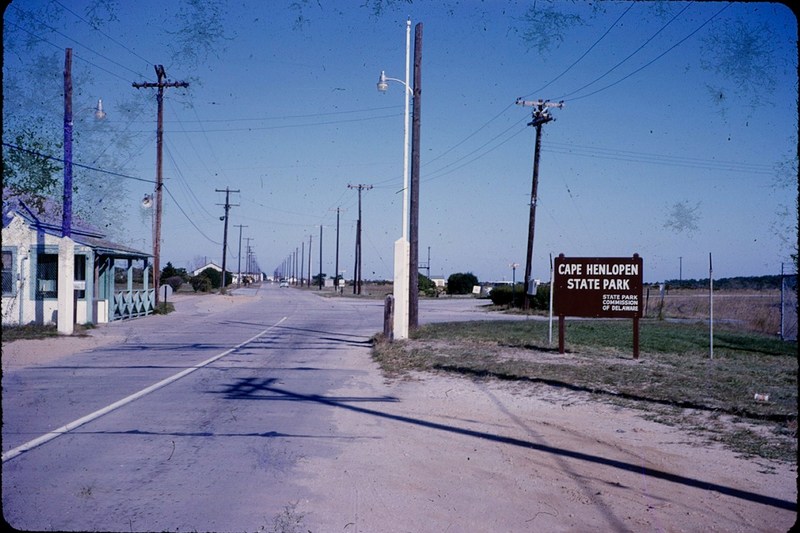The history of Cape Henlopen State Park dates back 50 years, but the rich history of the Cape area dates back centuries. Although designated as public lands, the park was used by the U.S. government during the late 18th century and most of the 19th century. The area was used by various military branches for more than 100 years.
There is no way to completely list the expansive history of the park area. Included are a few of the highlights over the past two centuries.
TIME LINE
1682: William Penn proclaims Cape Henlopen is to be used as public lands, some of the first established in the United States. The Warner Grant sets aside lands in what is now the park for "the usage of the citizens of Lewes and Sussex County."
1828: Delaware Breakwater construction begins.
1876: Cape Henlopen Life-Saving station established.
1884: Quarantine station opens and would later expand in 1890s.
1915: Life-saving Service disbanded.
1917: Small naval base is established; Army's 6-inch guns installed to defend Delaware Bay entrance during World War I. First gun is installed on the point in 1918.
1938: Federal government determines that area should be a national park. Agreement signed with Lewes officials that land would be park unless needed for national defense.
1938: Coast Guard station construction on Cape.
1940: In the spring, U.S. Army moves in and starts construction of Fort Miles. Over the next few years, 250 buildings and 16 underground structures are built to house up to 2,300 men. Fort Miles becomes larger than Lewes during the war years. Fort is previously a Coast Guard station.
1941: Cape Henlopent Life-Saving Station falls into the sea.
1943: Fort Miles is completed.
1945: On May 14, German U-boat 858 surrenders at Fort Miles. Prisoners are housed in what is now the park's nature center and perform farm labor in the area until 1948.
1945-1947: On-shore rocket tests take place from the Cape as part of Operation Bumblebee. Many of the secret rockets were reported as UFOs by locals.
1956: Navy takes control of batteries and bunkers. Rest of area becomes Fort Miles Recreation Area.
1961, 1962: U.S. Navy creates listening post SOSUS for Soviet subs at Battery Herring and Battery Smith; current Biden Center is built. Base operates into 1970s.
1962: Operation Wet Horse amphibious landings at Fort Miles during Berlin crisis.
1964: Department of Defense declares that 543 acres of Cape lands as surplus property. The state accepts the property to establish Cape Henlopen State Park. The park – opening Oct. 17 – now contains nearly 5,200 acres.
1970: Earth Day protest stops Army from leveling Great Dune for recreation expansion.
1986: Portion of hull of HM Brig DeBraak raised and brought to the park for study and preservation.
1990: Underwater warfare units train for Operation Desert Storm.
1991: The last U.S. military unit is housed in the park.
1992: Fort Miles officially closes.
1996: Last land grant transfers additional land to park.
1996: After nearly 100 years on the property, the military leaves.
ALONG THE CAPE
1767: Cape Henlopen Lighthouse goes into operation.
1825: Cape Henlopen Beacon built on a 45-foot tower to mark point of the Cape.
1864: Beacon is replaced with a screwpile lighthouse.
1828: Work begins on 2,100-foot inner breakwater and 1,700-foot ice breaker. It's the first project of its kind in the Western Hemisphere and the third in the world.
1883: Work begins to close gap between the breakwaters; completed in 1898.
1871: U.S. Army Corps of Engineers builds a 1,700-foot iron pier to carry rail traffic to ships in the harbor.
1885: Delaware Breakwater East End Light is operational.
1896, 1897: U.S. Congress votes to build National Harbor of Refuge off Cape Henlopen and north of the original breakwater. The outer breakwater is 8,000 feet long and 40 feet wide with a 1,300-foot ice breaker; completed in 1901.
1920: Cape Henlopen Lighthouse damaged by a storm.
April 13, 1926: After being abandoned for two years, the Cape Henlopen Lighthouse finally succumbs to the moving sands of the point and falls into the sea around 12:45 p.m.
1926: Harbor of Refuge Light is operational.
1938: U.S. Coast Guard builds station near current location of Cape May-Lewes Ferry. It's now the Delaware River pilots' station.
July 1, 1964: Cape May-Lewes Ferry begins operation
UFOs, German subs and a zeppelin
There has been an extreme amount of research conducted on the area known as Cape Henlopen State Park, uncovering everything from UFOs to a presidential visit.
During World War I, German subs operate off the coast of the Cape. Some laid mines; several U.S. and British ships are damaged or sunk.
In 1921, World War I hero Gen. Billy Mitchell conducts aerial battleship bombings taking off from a Cape area landing strip.
In August 1941, 600-800 workers at Fort Miles go on strike seeking higher wages to $1.50 per hour.
On Oct. 28, 1933, the German airship Graf Zeppelin flies over the area.
In 1947, UFOs are reported off the Cape and are included in official documents as Blue Book Incident #65.
On Aug. 23 and Aug. 24, 1948, President Harry Truman makes a stop in the Presidential yacht Williamsburg in the Harbor of Refuge. Some accounts have the president swimming ashore to Fort Miles.
During the summer of 1943, troops from Fort Miles help local farmers harvest the lima bean crop.
Scandal rocks the Cape in November and December of 1943 when a Fort Miles officer is convicted of involuntary manslaughter in what the state charged was the love-triangle shooting of his fellow officer.
On May 11, 1960 the U.S.S. Triton submarine surfaces at Cape Henlopen after circumnavigating the globe. The captain is airlifted to meet President Dwight Eisenhower in Washington, D.C.
For more historical information, go to destateparks.com/park/cape-henlopen, fortmiles.org or www.navyatcapehenlopen.info/plussubmarinesatcape.html.































































